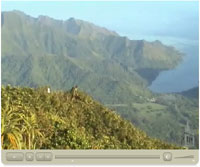 Video: Cataloging an ecosystem |
Moorea, home of the UC Berkeley Richard B. Gump South Pacific Research Station and France's Centre de Recherches Insulaires et Observatoire de l'Environnement (CRIOBE), will be the site of an ambitious project to create a comprehensive inventory of all non-microbial life on the island. Supported by a new $5.2 million grant from the Gordon and Betty Moore Foundation, the Moorea Biocode Project over the next three years will send researchers climbing up jagged peaks, trekking through lush forests and diving down to coral reefs to sample the French Polynesian island's animal and plant life.
"This is the first effort to catalog and barcode an entire tropical ecosystem, from the bottom of the ocean to the top of the mountains," said George Roderick, UC Berkeley professor of environmental science, policy and management, curator of the campus's Essig Museum of Entomology and co-principal investigator of the project.
"We're constructing a library of genetic markers and physical identifiers for every species of plant, animal and fungi on the island, then making that database publicly available as a resource for ecologists and evolutionary biologists around the world," he said. Roderick is a former director of the Gump Station, where the National Science Foundation has established one of its 26 Long Term Ecological Research sites (the Moorea Coral Reef LTER).
Other lead investigators on this project include Neil Davies, executive director of the Gump Station; Craig Moritz, UC Berkeley professor of integrative biology and director of the Museum of Vertebrate Zoology; Serge Planes, research scientist with France's Centre National de la Recherche Scientifique (National Center for Scientific Research, or CNRS) and director of CRIOBE; Chris Meyer, research zoologist at the Smithsonian Institute; and Jean-Yves Meyer, botanist and research management officer with the Government of French Polynesia's Research Department.
The work will expand upon a 2005 pilot biocode project at Moorea, also funded by the Moore Foundation, which tested the feasibility of such a large undertaking. That project was limited to genetic barcoding of the fishes, geckos and selected insects.
In the spirit of leaving no stone unturned, larvae and contents of animals'
guts will be fair game in the full project. "We'll check the gut contents of a gecko, spider or fish to find out what it's eating," said Chris Meyer, who managed the pilot project while he was a researcher at UC Berkeley. "This information will show how organisms fit together in the ecosystem, and because we will characterize every species on Moorea, we will be able to reconstruct the entire food web. With such a tool, ecologists in French Polynesia can pioneer a whole system approach to investigating how island food webs respond to disturbance, such as when invasive species enter the picture or sea temperatures rise."
There are an estimated 5,000 plant, animal and fungal species on Moorea, although that number may change as cryptic communities and organisms are sampled and genetic markers reveal novel species. "I'd be disappointed if we don't hit at least 10,000 species," said Meyer.
The number of species on the 51-square-mile island of Moorea is small compared with that on larger islands and continents. In California, for example, the number of insect species alone tops 30,000. Yet, the researchers say Moorea provides the right balance of being small enough to be studied manageably while being sufficiently complex to reliably serve as a microcosm of the challenges faced in larger ecosystems.
Charting the state of coral reefs off the island's coast, for example, could shed light on the impact of climate change, while documenting the invasive species that have been introduced to the island would speak to the effects of globalization. Creating a record of all of the island's species can also highlight localized human-generated problems such as over-fishing, habitat destruction and pollution.
"Virtually all the ecosystems in the world are under these same stresses, and how they are responding to them is what we need to understand," said Davies, the lead principal investigator on the grant. "A model ecosystem approach to ecology will benefit conservation much like model organisms - from fruit flies to roundworms - in molecular biology have benefited medicine. There is a great deal of insight researchers can obtain about very complex systems by first studying simple ones. Much of what we learn at Moorea will be applicable elsewhere."
The biocode study will also help scientists understand the evolution of the island's species over the millennia, said Moritz, co-principal investigator of this project. He notes that while a number of non-native insects or plants have drifted in on the wind or been carried over by birds, humans are credited with - or blamed for - bringing larger animals to the island, including rats.
"By comparing the genetic barcode of species on this island with those on other islands, we can get a sense of how long they've been on Moorea, and thus how they likely arrived," said Moritz. "The whole history of this island is one of invasion, and this project will help untangle a bit of that history."
At the end of the three-year project, the Moorea Biocode Project will have sequenced a whole tropical ecosystem. "Like the Human Genome Project, however, this unprecedented accomplishment is, in some ways, merely a necessary first step," said Davies. "Its goal is to accelerate progress on the larger questions: how to maintain a healthy ecosystem and what to do when things go wrong."
Additional information about the Moorea Biocode Project is available at: http://moorea.berkeley.edu/biocode.
--Sarah Yang, UCB Public Affairs
